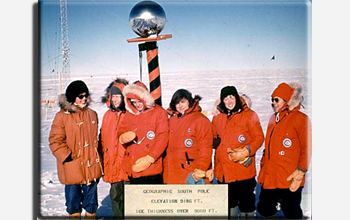Stepping into history: Women mark 40 years of working in the U.S. Antarctic Program
November 13, 2009
The U. S. Antarctic Program marks a significant milestone this month. It was 40 years ago when the first women scientists from the United States were finally allowed to work in Antarctica. On 12 November 1969, six women joined arms and stepped off the ramp of a ski-equipped Hercules LC-130 and onto the nearly two-mile-thick ice sheet at South Pole, the first time any women had been to the bottom of the planet.
The 13 November 2009 issue of the Antarctic Sun features five stories about the event. Find links to all of the features on the page Stepping into History. Two of the main articles include:
- Breaking the Ice: Terry Tickhill Terrell was a 19-year-old undergraduate student in 1969 when she walked into the then-Institute of Polar Studies at Ohio State University and announced that she wanted to go to Antarctica. Silent stares greeted her announcement. Women didn't go to Antarctica in those days. All that was about to change.
- Long Time Coming: It wasn't too long after the ranks of researchers opened up to women in 1969 that they started to fill support roles - first in the U.S. Navy and then increasingly among the civilian workforce that eventually took over most jobs today from the military.
To read more about science and related activities supported by the U.S. Antarctic Program, which is funded and managed by the National Science Foundation, subscribe to the Antarctic Sun at http://antarcticsun.usap.gov/contentHandler.cfm?id=1192.
The U.S. National Science Foundation propels the nation forward by advancing fundamental research in all fields of science and engineering. NSF supports research and people by providing facilities, instruments and funding to support their ingenuity and sustain the U.S. as a global leader in research and innovation. With a fiscal year 2023 budget of $9.5 billion, NSF funds reach all 50 states through grants to nearly 2,000 colleges, universities and institutions. Each year, NSF receives more than 40,000 competitive proposals and makes about 11,000 new awards. Those awards include support for cooperative research with industry, Arctic and Antarctic research and operations, and U.S. participation in international scientific efforts.
Connect with us online
NSF website: nsf.gov
NSF News: nsf.gov/news
For News Media: nsf.gov/news/newsroom
Statistics: nsf.gov/statistics/
Awards database: nsf.gov/awardsearch/
Follow us on social
Twitter: twitter.com/NSF
Facebook: facebook.com/US.NSF
Instagram: instagram.com/nsfgov



